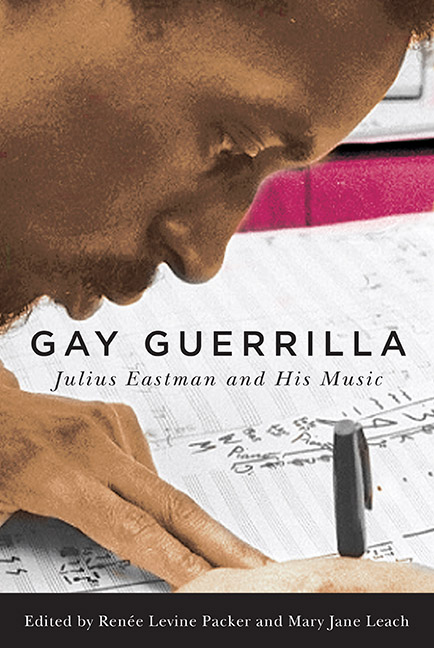Book contents
- Frontmatter
- Contents
- Foreword
- Acknowledgments
- Introduction: Julius Eastman and His Music
- 1 Julius Eastman, A Biography
- 2 Unjust Malaise
- 3 The Julius Eastman Parables
- 4 Julius Eastman and the Conception of “Organic Music”
- 5 Julius Eastman Singing
- 6 An Accidental Musicologist Passes the Torch
- 7 A Flexible Musical Identity: Julius Eastman in New York City, 1976–90
- 8 Evil Nigger: A Piece for Multiple Instruments of the Same Type by Julius Eastman (1979), with Performance Instructions by Joseph Kubera
- 9 A Postminimalist Analysis of Julius Eastman’s Crazy Nigger
- 10 “That Piece Does Not Exist without Julius”: Still Staying on Stay On It
- 11 Connecting the Dots
- 12 Gay Guerrilla: A Minimalist Choralphantasie
- Appendix: Julius Eastman Compositions
- Chronology
- Selected Bibliography
- List of Contributors
- Index
- Eastman Studies in Music
11 - Connecting the Dots
Published online by Cambridge University Press: 26 May 2021
- Frontmatter
- Contents
- Foreword
- Acknowledgments
- Introduction: Julius Eastman and His Music
- 1 Julius Eastman, A Biography
- 2 Unjust Malaise
- 3 The Julius Eastman Parables
- 4 Julius Eastman and the Conception of “Organic Music”
- 5 Julius Eastman Singing
- 6 An Accidental Musicologist Passes the Torch
- 7 A Flexible Musical Identity: Julius Eastman in New York City, 1976–90
- 8 Evil Nigger: A Piece for Multiple Instruments of the Same Type by Julius Eastman (1979), with Performance Instructions by Joseph Kubera
- 9 A Postminimalist Analysis of Julius Eastman’s Crazy Nigger
- 10 “That Piece Does Not Exist without Julius”: Still Staying on Stay On It
- 11 Connecting the Dots
- 12 Gay Guerrilla: A Minimalist Choralphantasie
- Appendix: Julius Eastman Compositions
- Chronology
- Selected Bibliography
- List of Contributors
- Index
- Eastman Studies in Music
Summary
Julius Eastman was an opportunistic composer, and I mean that in the best way. He had a habit of situational writing, using whatever resources were available. When all else failed, he would create solo works for himself, most of which weren't notated (with the exception of his college compositions, assuming that they had to be notated). Since he was a singer and a pianist, his solo works were for solo voice, solo piano, or both. He also observed and synthesized musical ideas/approaches that he was exposed to into his own compositions.
I will be writing about the arc of Julius Eastman's compositions through his instrumentation, from his earliest known pieces to his last ones, beginning with solo or duo notated pieces; to writing pieces with an expanded instrumentation, using a combination of traditional notation, graphic notation, and improvisation; and ending with solo or duo notated pieces. I will also write about his two Joan pieces: The Holy Presence of Joan d’Arc (Joan), for ten cellos, and Prelude to The Holy Presence of Joan d’Arc, for solo voice. They form an interesting pair: a solo piece that was a structured improvisation, paired with a fully notated piece as dense as the solo piece is transparent. In addition, I will explore some of his influences from other composers and performers, and how these were incorporated into his work. Other essays in this book extensively discuss Stay On It, Crazy Nigger, Evil Nigger, and Gay Guerrilla, four of Eastman's most substantial pieces that explore some of his other compositional trends.
There are no scores or recordings of the pieces that Eastman wrote while attending Curtis Institute; there are only titles, instrumentation, and remembrances. They were primarily for piano, or piano and voice, and had fairly traditional titles (Sonata, Birds Fly Away, I Love the River), and a few had somewhat provocative titles (Insect Sonata and The Blood). The Blood had the most expansive instrumentation—nine singers and piano— and was written mostly for friends of his at Curtis.
The only works that appear to have been written in the few years after Eastman's graduation from Curtis are short pieces for solo piano (Piano I– IV) and a string quartet.
- Type
- Chapter
- Information
- Gay GuerrillaJulius Eastman and His Music, pp. 179 - 190Publisher: Boydell & BrewerPrint publication year: 2015



